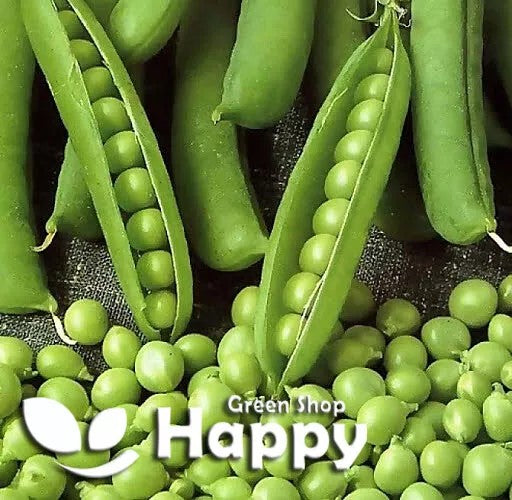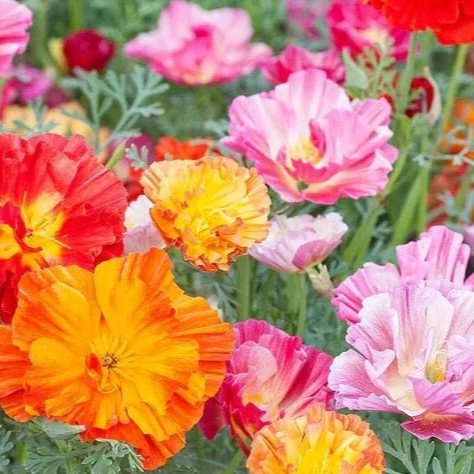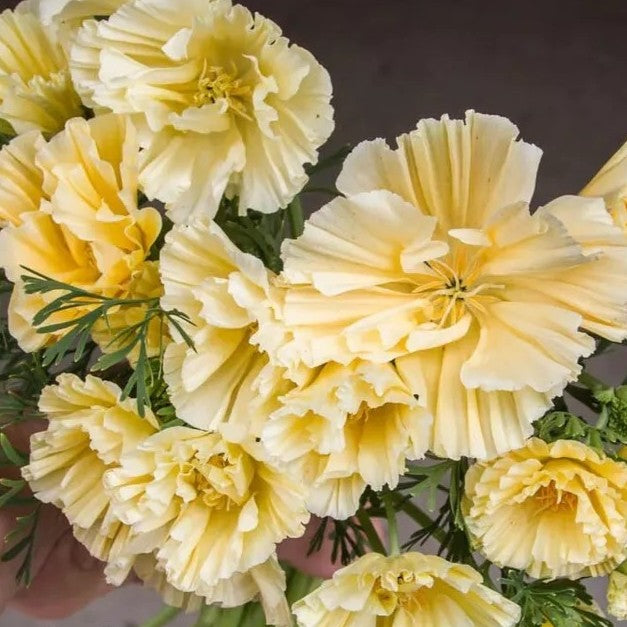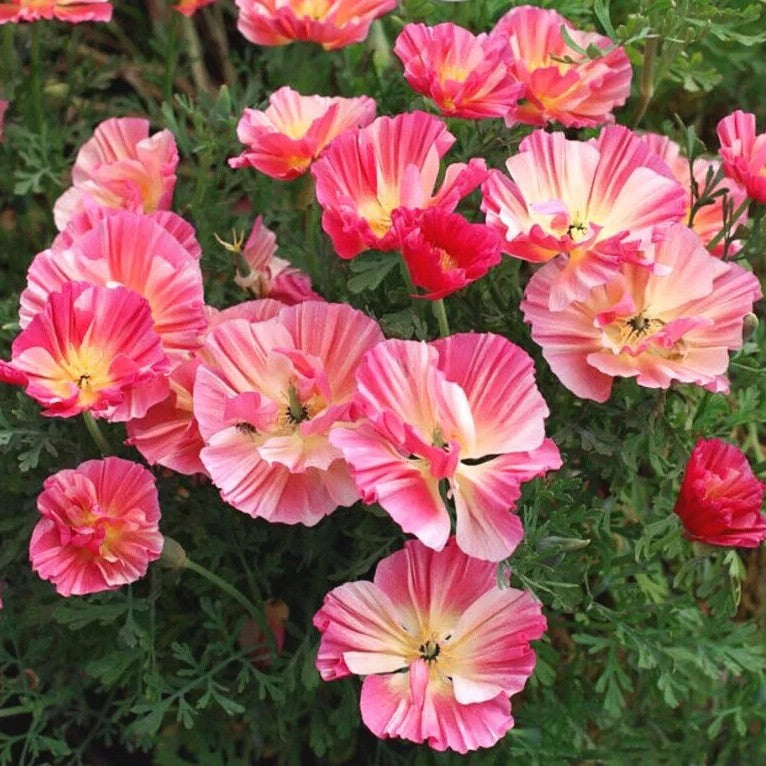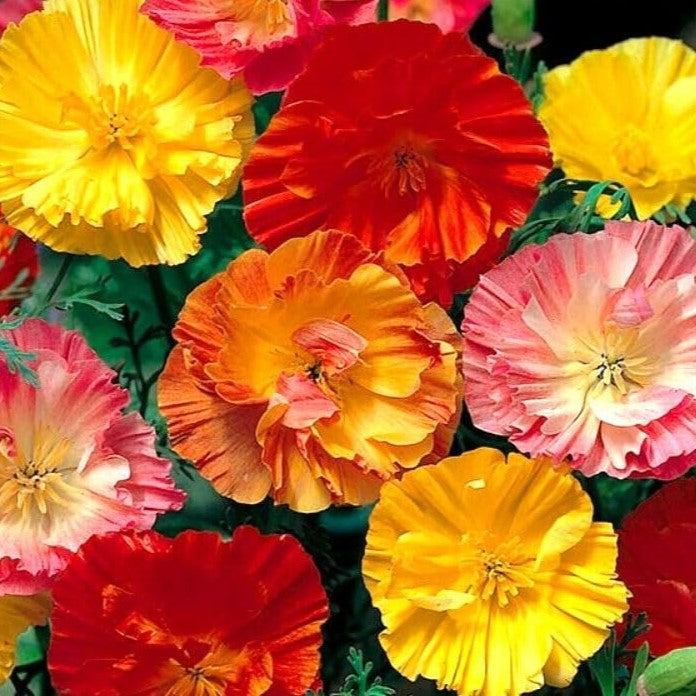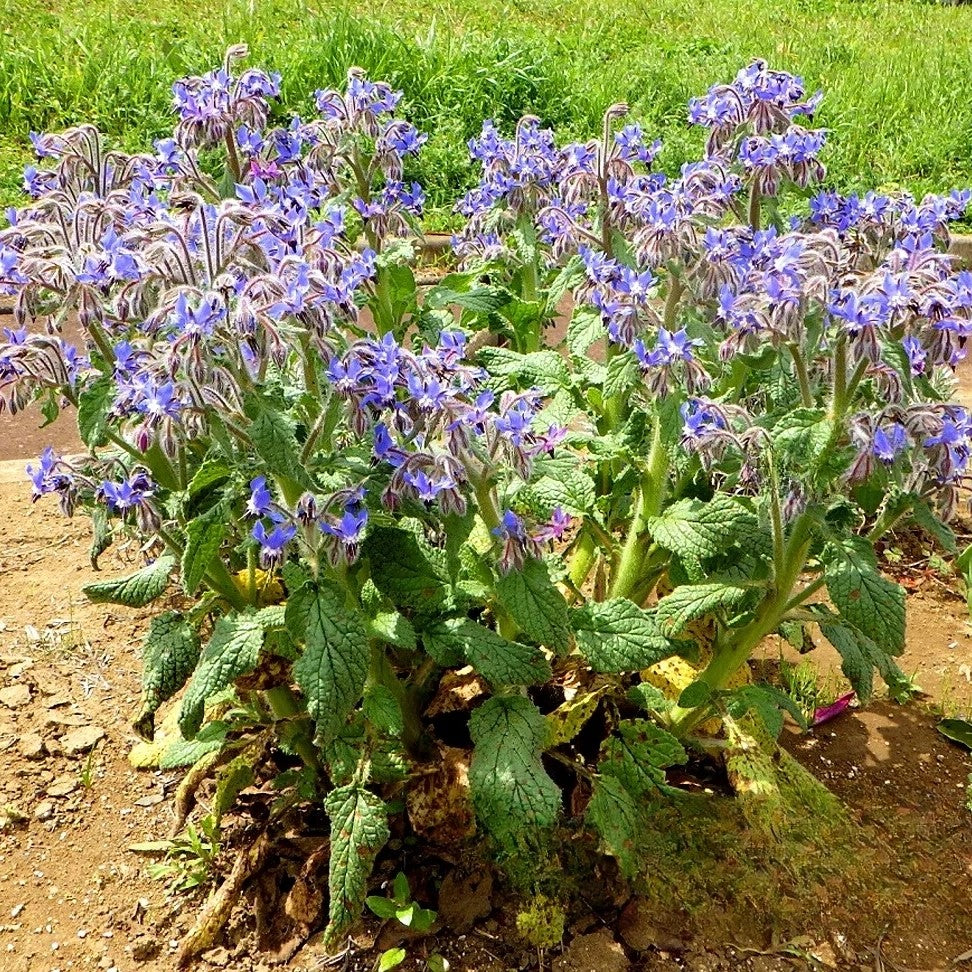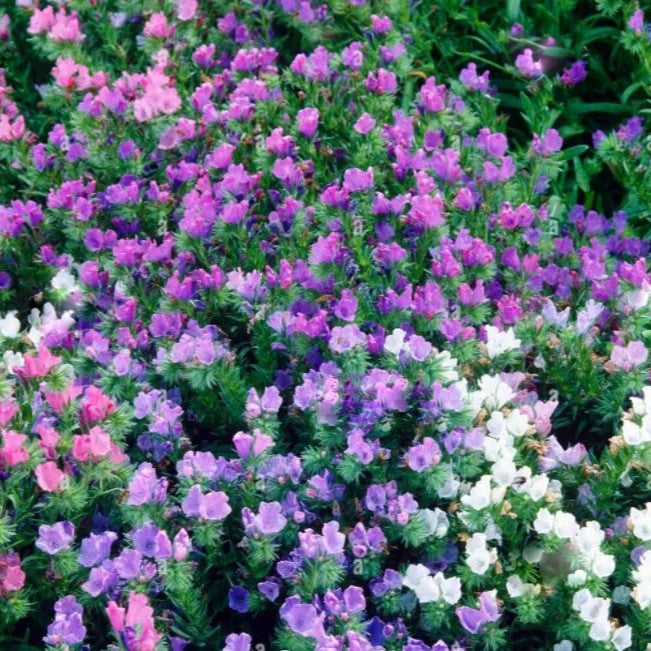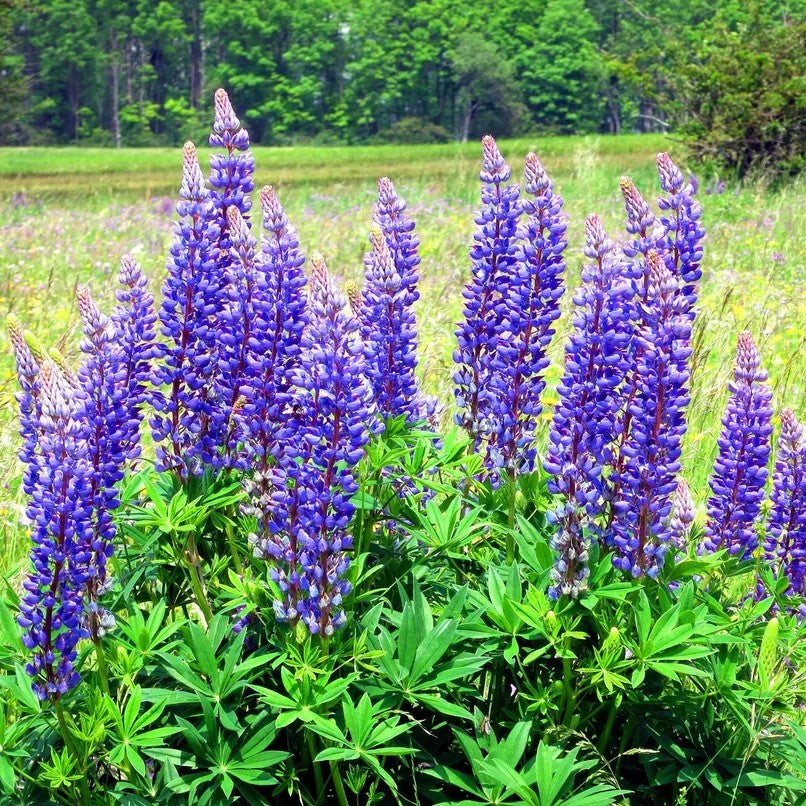Sort by:
351 products
351 products
California Poppy ‘Golden West’ – 2,500 Seeds (Eschscholzia californica)
California Poppy ‘Golden West’ (Eschscholzia californica) is a vibrant, hardy annual producing brilliant golden-orange blooms that light up borders, meadows, and large-scale plantings. Fast-growing and low-maintenance, it thrives in sunny, well-drained locations and attracts pollinators. Perfect for naturalized gardens or mass displays, it offers long-lasting summer color.
Why Grow "Golden West"
-
Brilliant golden-orange blooms
-
Fast-growing and hardy
-
Long-lasting flowering from spring to summer
-
Attracts bees and other pollinators
Key Features
-
Type: Annual (Eschscholzia californica)
-
Height: 30–45 cm
-
Flowering: May–September
-
Position: Full sun
-
Uses: Borders, meadows, naturalized gardens, mass plantings
Ideal For
-
Large-scale and naturalized plantings
-
Pollinator-friendly gardens
-
Cottage-style or wildflower borders
-
Low-maintenance, sunny garden spaces
Sowing & Growing
-
Sow outdoors: March–May directly in prepared soil
-
Germination: 10–15 days at 15–20°C
-
Thin seedlings to 15–20 cm apart
-
Prefers full sun and well-drained soil
-
Deadhead to prolong flowering if desired
California Poppy ‘Frilly Fun’ Seeds (Eschscholzia californica)
Add a burst of playful charm to your garden with California Poppy ‘Frilly Fun’ (Eschscholzia californica). This unique variety of the classic California poppy produces finely frilled, ruffled petals in vibrant shades of orange, yellow, and gold. Hardy, drought-tolerant, and easy to grow, it’s the perfect choice for brightening beds, borders, and wildflower-style plantings.
How to Grow
-
Sow directly outdoors in spring or autumn, as California poppies dislike transplanting.
-
Choose poor to moderately fertile, well-drained soil in full sun.
-
Scatter seeds thinly on the surface and cover lightly with fine soil.
-
Water gently until established; then reduce watering, as plants thrive in dry conditions.
-
Germination usually occurs within 14–21 days.
-
Deadhead spent blooms to encourage continued flowering.
Key Features
-
Distinctive frilly, ruffled blooms in bright golden shades
-
Hardy, drought-tolerant annual, perfect for low-maintenance gardens
-
Long-flowering, bringing color from summer into autumn
-
Attracts pollinators including bees and butterflies
-
Excellent for naturalistic and wildflower-style plantings
Ideal For
-
Wildflower meadows and cottage gardens
-
Rock gardens and sunny borders
-
Low-maintenance landscapes
-
Adding cheerful color to poor or dry soils
Sowing
-
Best time: Spring or autumn directly outdoors
-
Germination: 14–21 days
-
Sow thinly, cover lightly, and water until established
-
Prefers full sun and free-draining soil
Quick Tip
-
For a natural, meadow-like effect, scatter seeds in drifts rather than rows.
California Poppy ‘Ballerina’ Mix – Seeds (Eschscholzia californica)
California Poppy ‘Ballerina’ Mix (Eschscholzia californica) offers a charming blend of delicate, cup-shaped blooms in soft pastel shades of pink, cream, and apricot. This low-maintenance annual brightens borders, rockeries, and wildflower gardens with a long flowering season. Fast-growing and drought-tolerant, it’s perfect for sunny spots and pollinator-friendly gardens.
Why Grow "Ballerina Mix"
-
Soft, pastel-colored blooms in pink, cream, and apricot
-
Long flowering season from spring to autumn
-
Low-maintenance, drought-tolerant annual
-
Attracts bees and other pollinators
Key Features
-
Type: Annual (Eschscholzia californica)
-
Height: 30–40 cm
-
Flowering: May–October
-
Position: Full sun, well-drained soil
-
Uses: Borders, rockeries, wildflower meadows, pollinator gardens
Ideal For
-
Sunny borders and rockeries
-
Wildflower and cottage-style gardens
-
Pollinator-friendly plantings
-
Low-maintenance summer color
Sowing & Growing
-
Sow outdoors: March–May directly in prepared soil
-
Germination: 7–14 days at 15–20°C
-
Thin seedlings to 20–30 cm apart
-
Prefers full sun and well-drained soil
-
Deadhead to encourage prolonged flowering
Butterfly Wildflower Mix – 1g Seeds
Bring your garden to life with the Butterfly Wildflower Mix, specially selected to attract butterflies and other pollinators. This colorful blend combines hardy annuals and perennials that provide nectar-rich flowers from early summer through autumn. Easy to sow and low-maintenance, it creates a vibrant, wildlife-friendly display that supports biodiversity.
Why Grow Butterfly Wildflower Mix?
-
Specially formulated to attract butterflies
-
Long season of nectar-rich blooms
-
Easy to sow directly outdoors
-
Supports pollinators and biodiversity
Key Features
-
Type: Annuals and perennials mix
-
Height: 30–90 cm
-
Flowering: June–October
-
Position: Full sun
-
Coverage: 1 g covers approx. 1–2 m²
Ideal For
-
Wildlife and pollinator gardens
-
Naturalized areas and meadows
-
Cottage gardens and borders
-
Low-maintenance landscapes
Sowing & Growing
-
Sow outdoors: March–June or September
-
Rake soil to a fine tilth, scatter seeds evenly, cover lightly
-
Water gently until established
-
Thin seedlings where necessary
-
Allow some plants to self-seed for following years
Tip: For best results, sow in a sunny spot with poor to moderately fertile soil.
Buttercup – Seeds (Ranunculus acris)
Buttercup is a cheerful wildflower known for its glossy, golden-yellow blooms that light up meadows, borders, and cottage gardens. This hardy perennial thrives in a wide range of soils and naturalizes easily, creating bright, natural drifts of color from late spring into summer. A classic symbol of the countryside, it’s a simple yet charming addition to wildlife-friendly gardens.
Why Grow "Buttercup"
-
Bright, glossy yellow flowers
-
Hardy and easy to grow
-
Naturalizes well in meadows and borders
-
Attracts bees and other pollinators
Key Features
-
Type: Perennial (Ranunculus acris)
-
Height: 40–60 cm
-
Flowering: Late spring to summer
-
Position: Full sun to partial shade
-
Uses: Meadows, cottage gardens, borders, wildlife areas
Ideal For
-
Naturalizing in wildflower meadows
-
Adding cheerful yellow to borders and beds
-
Pollinator-friendly gardens
-
Low-maintenance, classic garden charm
Sowing & Growing
-
Sow outdoors: Autumn or spring, directly in soil
-
Germination: 14–28 days
-
Thin seedlings: 20–30 cm apart
-
Prefers moist, well-drained soil in sun or light shade
Burning Bush – Seeds (Dictamnus fraxinella)
Burning Bush (Dictamnus fraxinella) is a striking perennial known for its tall spikes of fragrant, pink to white flowers that bloom from late spring to early summer. Its aromatic foliage releases a citrus-like scent when touched, adding sensory interest to borders and cottage gardens. Hardy and long-lived, this unique plant attracts pollinators and makes an eye-catching addition to perennial beds.
Why Grow "Burning Bush"
-
Tall spikes of fragrant pink to white flowers
-
Aromatic foliage with a citrus-like scent
-
Hardy, long-lived perennial
-
Attracts bees, butterflies, and other pollinators
Key Features
-
Type: Perennial (Dictamnus fraxinella)
-
Height: 60–100 cm
-
Flowering: Late spring to early summer
-
Position: Full sun to partial shade
-
Uses: Borders, cottage gardens, perennial beds, pollinator gardens
Ideal For
-
Adding vertical interest and fragrance to borders
-
Cottage and mixed perennial garden designs
-
Pollinator-friendly planting
-
Gardeners seeking unique, low-maintenance perennials
Sowing & Growing
-
Sow indoors: 6–8 weeks before last frost
-
Sow outdoors: After frost danger has passed
-
Germination: 14–28 days (may require cold stratification)
-
Space seedlings: 30–40 cm apart
-
Prefers well-drained soil and sunny to partially shaded locations
Borage – Seeds
(Borago officinalis) – Edible Flowers & Pollinator Magnet
Borage, also known as the starflower, is a fast-growing annual herb admired for its vivid blue, star-shaped flowers and fuzzy, cucumber-flavored leaves. A favorite of bees, butterflies, and other pollinators, it makes an excellent addition to herb gardens, vegetable patches, or pollinator-friendly borders. Both flowers and young leaves are edible – perfect for garnishing salads, desserts, drinks, or freezing into ice cubes.
Key Features
-
Plant type: Annual herb
-
Height: 50–70 cm
-
Spread: 30–40 cm
-
Flowers: Bright blue, star-shaped
-
Foliage: Grey-green, hairy leaves with cucumber flavor
-
Position: Full sun to light shade
-
Soil: Moderately fertile, well-drained
Ideal For
-
Herb & cottage gardens
-
Attracting pollinators (especially bees)
-
Edible flowers & herbal teas
-
Companion planting with tomatoes, strawberries, and courgettes
Sowing & Growing
-
Sow outdoors: April–June, direct in soil, 1 cm deep.
-
Germination: 7–14 days.
-
Spacing: Thin to 30 cm apart.
-
Flowering: June–September.
Care Tips
-
Easy to grow and self-seeding – will naturalize readily.
-
Pinch back growing tips for bushier plants.
-
Collect flowers regularly to encourage continuous blooming.
-
Water in dry spells but avoid overwatering.
Blueweed Flower Mix Seeds (Echium plantagineum)
The Blueweed Flower Mix is a vibrant and easy-to-grow annual that produces a spectacular display of blue, pink, violet, and purple trumpet-shaped blooms. Also known as Paterson’s Curse, this wildflower is prized for its striking colors and its ability to attract bees, butterflies, and other pollinators throughout summer. Perfect for naturalistic planting, wildflower meadows, or borders, this hardy mix thrives in poor soils and sunny sites, offering months of color with minimal care.
What Makes It Special
-
Long-lasting multi-colored floral display
-
Excellent for wildlife-friendly gardens
-
Thrives in dry, poor soils where other flowers may struggle
-
Perfect choice for naturalistic meadows and pollinator habitats
Key Features
-
Botanical name: Echium plantagineum
-
Common name: Blueweed / Paterson’s Curse
-
Seed count: Approx. seeds per pack
-
Height/Spread: 30–80 cm tall, 20–40 cm spread
-
Position: Full sun; well-drained sandy or gravelly soil
-
Flowering period: June–September
Ideal For
-
Wildflower meadows
-
Pollinator-friendly planting
-
Cottage gardens
-
Low-maintenance beds and borders
-
Naturalizing in sunny, dry spots
Sowing Instructions
-
When to sow: March–May outdoors or September for earlier blooms next year
-
How to sow:
-
Sow seeds directly where they are to flower, in well-prepared soil
-
Lightly rake in and firm down
-
Keep soil moist until germination (7–14 days)
-
-
Spacing: Thin seedlings to 20–30 cm apart
-
Care: Once established, requires very little maintenance. Tolerant of drought. Deadhead to prolong flowering.
Blue Lupine – Seeds (Lupinus angustifolius)
Blue Lupine (Lupinus angustifolius) is a stunning annual or short-lived perennial producing tall spikes of vivid blue pea-like flowers. Blooming from late spring to early summer, it adds vertical interest and vibrant color to borders, cottage gardens, and mixed flower beds. Hardy and easy to grow, this variety attracts bees and butterflies, making it perfect for pollinator-friendly gardens and long-lasting summer displays.
Why Grow "Blue Lupine"
-
Tall spikes of striking blue flowers
-
Long flowering season from late spring to early summer
-
Hardy, low-maintenance annual or short-lived perennial
-
Pollinator-friendly and adds vertical interest
Key Features
-
Type: Annual/Short-lived perennial (Lupinus angustifolius)
-
Height: 60–90 cm
-
Flowering: Late spring to early summer
-
Position: Full sun
-
Uses: Borders, cottage gardens, mixed flower beds, pollinator gardens
Ideal For
-
Vertical color in borders and mixed beds
-
Cottage-style gardens
-
Pollinator-friendly planting schemes
-
Long-lasting summer floral displays
Sowing & Growing
-
Sow indoors: February–April in trays or pots
-
Sow outdoors: April–May after frost
-
Germination: 14–21 days at 18–22°C
-
Thin seedlings 25–30 cm apart
-
Prefers well-drained soil in full sun
-
Mulch in winter for protection in colder regions
Showing 315/351

